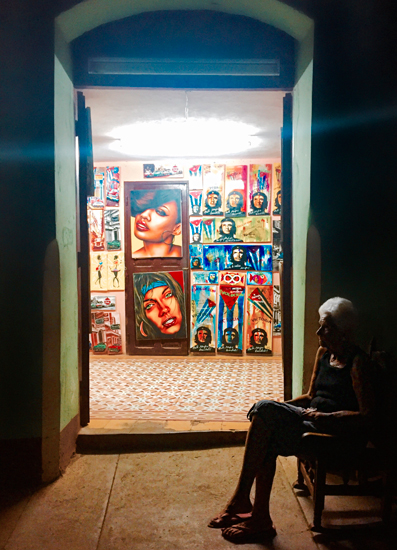When considering a trip to Cuba, the immediate thoughts will usually be of the beaches, the salsa, the mojitos. But the true appeal of the Caribbean’s largest island stems from its intrigue. It is easy to gain a false impression that with Cuba’s fascinating seclusion comes an unwelcoming, desolate society. This is not the case. On the contrary, the upbeat lifestyle that is on offer is unlike any place on earth, with Trinidad being the pinnacle of Cuba’s vibrancy.
The southern city is famed for its colourful architecture. It is impossible not to marvel over the bold and contrasting colours visible from every angle. And what makes Trinidad particularly unique is that the charm the city upholds isn’t limited to just the central neighbourhoods. On the contrary, the concrete rainbow stretches through even the poorest of areas, forming a sense of energy where things would be otherwise dismal.
When noticing a man, Blas Niebla, 55, repainting his home, I stopped to question the reason behind his choice of a compelling indigo colour. His response was simple: “I’ve painted this house twice before. I could have changed the colour to red or yellow but then it wouldn’t feel like home.” This revealed to me the personal significance that colour has for the locals. Despite homes elsewhere being defined by their style, furniture, or fittings; homes in Trinidad are made unique to the inhabitants by their colour.

A Trinidad ceramic shop with its colourful wares | James Rae
The upbeat atmosphere is exemplified through far more than just the buildings. Colourful beauty is just as present before even entering the city. In the outskirts there are ample opportunities to trek through the jungle and experience the vast array of plant life, or visit white sand beaches fronting the turquoise Caribbean Sea such as Playa Ancón.
Moreover, the vibrancy is just as blatant within the walls of these kaleidoscopic local homes. Like anywhere, the key to achieving this is through artwork. For this reason, the streets of Trinidad are riddled with boutique-style stalls and shops, each offering a myriad of saturated paintings, psychedelic ornaments and ceramics, along with much more.
While visiting a family run-ceramics store founded in the 19th century, I had the opportunity to ask the owner, Daniel Santander, 72, about the history of Trinidad’s colour. “Colour was not that important to the people of Trinidad before,” he said. “As a child, none of the houses were painted, and during my lifetime I have seen the city change into the most colourful in Cuba. We like to maintain tradition and this is one now.”
Intrigued by what may have triggered the burst of colour, I asked Yosleivy González, a local resident and tourist guide with vast knowledge on the city’s history, about it. She explained that the colouring of buildings began as a means of distinguishing one’s social class. Homes owned by the rich would be painted in gold to flaunt their worth, while blue was assigned to the poor. As society progressed, individual colours lost their meaning and residents are now free to choose, however, the grandest of buildings generally remain in their golden shade.

A Trinidad ceramic shop with its colourful wares | James Rae
The prime reason behind the continuation of Trinidad’s vibrant lifestyle is, of course, the people. The personalities of the citizens match perfectly the lifestyle they project through their radiant homes from inside out, alluring 1950s American automobiles and attire that often contains an uplifting printed message.
These people are always eager to socialise, whether it be by inviting you to salsa dance, suggesting attractions to visit, or just being happy to help. My last interview was with the owner of an art shop, Dunia Aguila. Firstly, she explained, “The locals were influenced by the coloured vehicles that Cuba is famous for. Now the world recognises Cuba for having colourful buildings too. There is a duty to keep that up, and Trinidad has done this very well.”
Using the word ‘duty’ seemed unusual at first, because, on the surface, the colourful buildings appear fun and light-hearted. However, to the residents, maintaining this tradition is more out of pride for their country, knowing that if they participate, they are playing a part in flaunting their city’s fame and beauty, which attracts people from all across the globe.
I then asked Dunia the direct question of why is Trinidad so colourful? Her answer was just as simple: “Trinidad is a happy place with happy people.”
Travel Journalism & Photography Internship Seminar in Havana and Trinidad, Cuba

